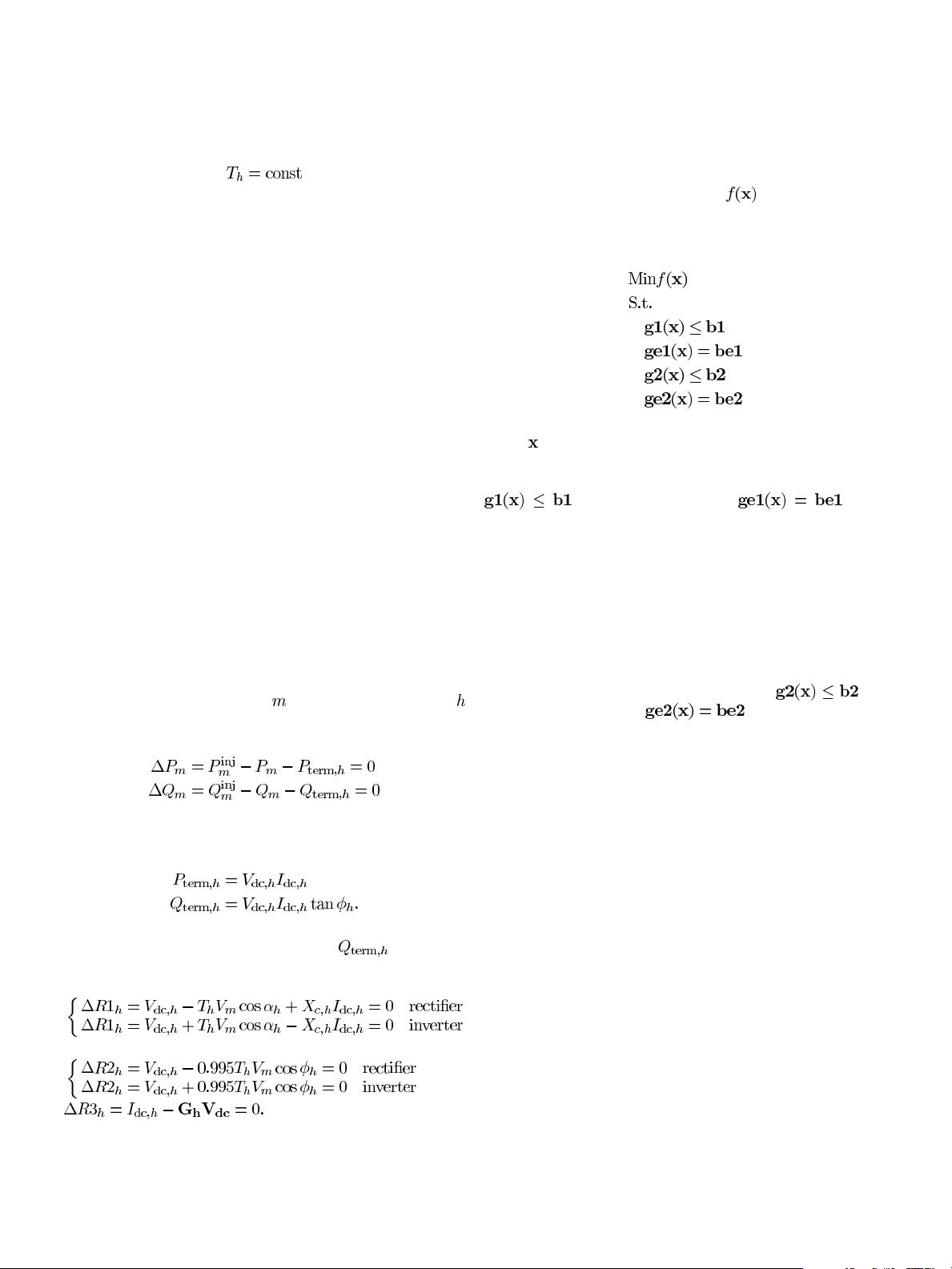
532 IEEE TRANSACTIONS ON POWER SYSTEMS, VOL. 25, NO. 1, FEBRUARY 2010
Power factor angle vector and its
increment.
Firing/extinction angle vector
and its increment.
Bus phase angle vector and its
increment.
Simplex multiplier vectors.
Initial AC bus real power
mismatch vector.
Initial AC bus reactive power
mismatch vector.
Initial mismatch vectors for DC
equations.
Upper and lower limit vectors for
incremental converter currents.
Increment vectors for AC and
DC line flows.
Upper and lower limit vectors for
incremental AC line flows.
Upper and lower limit vectors for
incremental DC line flows.
Incremental vector of reactive
power generation.
Upper and lower limit vectors for
incremental unit reactive power.
Increment vector for transformer
taps.
Upper and lower limit vectors for
incremental transformer taps.
Increment vectors for AC and
DC bus voltages.
Upper and lower limit vectors for
incremental AC voltages.
Increment vector for
phase-shifter angles.
Upper and lower limit vectors for
incremental phase-shifter angles.
Upper and lower limit vectors
for incremental firing/extinction
angles.
Upper and lower limit vectors for
incremental power factor angles.
I. I
NTRODUCTION
D
C transmission systems are often considered for deliv-
ering bulk power via long distances. The attributes of
DC transmission systems include low capacitance, low average
transmission cost in long distances, ability to prevent cascaded
outages in AC transmission systems, rapid adjustments for
direct power flow controls, ability to improve the stability of
AC transmission systems, mitigation of transmission conges-
tion, enhancement of transmission capacity, rapid frequency
Fig. 1. Market clearing process with AC/DC transmission.
control following a loss of generation, ability to damp out
regional power oscillations following major contingencies, and
offering major economic incentives for supplying loads [1]–[4].
Flexible and fast DC controls provide efficient and desirable
performance for a wide range of AC transmission systems [5].
Proper control modes applied to rectifiers (source) and in-
verters (sink) could maintain DC voltages near rated values and
set power factors as high as possible. DC transmission system
would require two control modes out of five for source and sink
operations. The control modes include fixed firing/extinction
advance angles, tap setting of converter transformers, DC cur-
rents, DC voltages, and DC power [6], [7]. The selection of DC
control modes depends on the nature of specific applications for
enhancing the economic and security.
DC transmission system configurations include monopolar,
bipolar, tripolar, and multi-terminal which are used in diverse
applications including the reinforcement of AC transmission
flows and the interconnection of several AC transmission sys-
tems with different operating frequencies [8].
In the past, DC transmission systems were modeled in the
optimal power flow (OPF) problem to analyze the impact of
DC transmission systems on the operation of AC transmission
systems [9], [10]. Several numerical techniques such as uni-
fied and sequential methods were considered for solving inte-
grated AC/DC transmission flow equations [11]–[13]. The uni-
fied method solves AC and DC power flow equations simulta-
neously. The sequential method applies an iterative procedure
between AC and DC transmission systems.
With the advent of electricity restructuring, DC transmission
systems were utilized to maintain the system security and de-
crease social costs. The simplest approach to consider DC trans-
mission systems in SCUC was to regard DC terminals as con-
stant power injections or withdrawals in AC transmission sys-
tems [14]–[16]. However, such simplified models in SCUC may
ignore the dependency of AC power flows to DC transmission
variables.
Fig. 1 depicts the market clearing process for AC/DC trans-
mission systems. The AC system includes AC generators,
loads, and transmission lines. The DC transmission system is
composed of converter terminals and DC transmission lines. At
first, the independent system operator (ISO) receives supply/de-
mand bids and collects AC/DC transmission data provided by
transmission companies (TRANSCOs). Once the market is
cleared, the ISO will send hourly schedules (unit commitment,
























